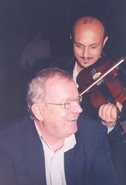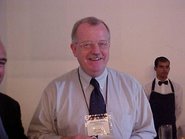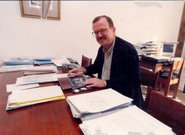 Often we think that behaviour change is based on a sequence of changes in knowledge and attitude. In reality change is not based on such linear process. I realized that when I was invited in the biodiversity fair in Nagoya to cut my own chop sticks out of bamboo. It was not easy. It was very helpful that a skilled Japanese old lady was demonstrating me the basics. It was also fun to try. I never had thought that practicing sustainable use, would reenforce so positively my attitude towards sustainability.
Often we think that behaviour change is based on a sequence of changes in knowledge and attitude. In reality change is not based on such linear process. I realized that when I was invited in the biodiversity fair in Nagoya to cut my own chop sticks out of bamboo. It was not easy. It was very helpful that a skilled Japanese old lady was demonstrating me the basics. It was also fun to try. I never had thought that practicing sustainable use, would reenforce so positively my attitude towards sustainability.
Sunday, 24 October 2010
Action triggers attitude change
 Often we think that behaviour change is based on a sequence of changes in knowledge and attitude. In reality change is not based on such linear process. I realized that when I was invited in the biodiversity fair in Nagoya to cut my own chop sticks out of bamboo. It was not easy. It was very helpful that a skilled Japanese old lady was demonstrating me the basics. It was also fun to try. I never had thought that practicing sustainable use, would reenforce so positively my attitude towards sustainability.
Often we think that behaviour change is based on a sequence of changes in knowledge and attitude. In reality change is not based on such linear process. I realized that when I was invited in the biodiversity fair in Nagoya to cut my own chop sticks out of bamboo. It was not easy. It was very helpful that a skilled Japanese old lady was demonstrating me the basics. It was also fun to try. I never had thought that practicing sustainable use, would reenforce so positively my attitude towards sustainability.
Saturday, 23 October 2010
Thursday, 21 October 2010
Saturday, 25 September 2010
Communicating science
 "...communication is not just one element in the struggle to make science relevant. It is the central element. Because if you gather scientific knowledge but are unable to convey it to others in a correct and compelling form, you might as well not even have bothered to gather the information.” This quote comes from the latest publication of marine biologist and film maker Randy Olsen: ‘Don’t be such a scientist: talking substance in an age of style’, Island Press 2009. In this book Olsen argues that scientists should pay more attention to how they communicate their work. They should focus not only on substance or content, but much more on the style of communication. As a professor in marine biology, Olsen had gained a reputation on a range of conservation issues. But only as a film maker he learned that information, facts and figures do not speak for themselves. At least when you are not teaching students or talking to your peers. Olsen explains how human psychology basically works. In the matrix I present my personal summary of his explanation. To get people – non-experts – to listen to your research or project findings, you have to first stimulate curiosity in them. You do that not through content but through style: humor, spontaneity, personal stories and messages. Only after you have ‘aroused’ your audience they are open for the content. Or in Olsen’s words: “When it comes to connecting with the entire audience you have four bodily organs that are important: your head, your heart, your gut, and your sex organs. The object is to move the process down out of your head, into your heart with sincerity, into your gut with humor, and , ideally if you’re sexy enough, into your lower organs with sex appeal.“
"...communication is not just one element in the struggle to make science relevant. It is the central element. Because if you gather scientific knowledge but are unable to convey it to others in a correct and compelling form, you might as well not even have bothered to gather the information.” This quote comes from the latest publication of marine biologist and film maker Randy Olsen: ‘Don’t be such a scientist: talking substance in an age of style’, Island Press 2009. In this book Olsen argues that scientists should pay more attention to how they communicate their work. They should focus not only on substance or content, but much more on the style of communication. As a professor in marine biology, Olsen had gained a reputation on a range of conservation issues. But only as a film maker he learned that information, facts and figures do not speak for themselves. At least when you are not teaching students or talking to your peers. Olsen explains how human psychology basically works. In the matrix I present my personal summary of his explanation. To get people – non-experts – to listen to your research or project findings, you have to first stimulate curiosity in them. You do that not through content but through style: humor, spontaneity, personal stories and messages. Only after you have ‘aroused’ your audience they are open for the content. Or in Olsen’s words: “When it comes to connecting with the entire audience you have four bodily organs that are important: your head, your heart, your gut, and your sex organs. The object is to move the process down out of your head, into your heart with sincerity, into your gut with humor, and , ideally if you’re sexy enough, into your lower organs with sex appeal.“
Tuesday, 21 September 2010
Behavior is less rational than we may think
 We tend to make ‘hot’ choices – “what I want to have”, over ‘cold’ choices – “who I want to be”. Satisfying immediate needs is an instinct humans share with animals: (fast) food, sex, power, whatever turns you on. Civilization has also brought other values, says psychologist Roos Vonk, but mostly those moral values lose from our instincts. We consume on impulses to satisfy our immediate desires. Even if it means compromising our moral values of fair trade, child labor, CO2 and ecological footprints, health etc. Unconsciously our mind ‘explains away’ the potential objections from our consciousness, so that we still can feel good, whatever choice we make.
We tend to make ‘hot’ choices – “what I want to have”, over ‘cold’ choices – “who I want to be”. Satisfying immediate needs is an instinct humans share with animals: (fast) food, sex, power, whatever turns you on. Civilization has also brought other values, says psychologist Roos Vonk, but mostly those moral values lose from our instincts. We consume on impulses to satisfy our immediate desires. Even if it means compromising our moral values of fair trade, child labor, CO2 and ecological footprints, health etc. Unconsciously our mind ‘explains away’ the potential objections from our consciousness, so that we still can feel good, whatever choice we make. Firstly our mind acts like a spin doctor when dealing with cognitive dissonancy: “For a healthy diet I simply need to eat meat”; “meat is just delicious, I can’t imagine a meal without it”; “I already do so much for the environment”; “Biological products are far too expensive”; “I only eat biological meat or buy fair trade products” Etc.
Secondly our mind unconsciously appeals to the paradigm of individualism: “I want to do my thing”, “I have a right to live and consume the way I prefer”, “I am free to choose what makes me happy”; “I happen to like buying new stuff”; “I do what is good for me”; “I follow my gut feelings and instincts” Etc.
Thirdly our mind appeals to dominant social and moral values: “it is not immoral to eat meat, to fly etc.”; “There is no law against…”; “The government acts in the same way”.
In communicating sustainability Roos argues it is best to address the hot choices by appealing to cold the ones: “do you have an inferiority complex that you need to drive a Hummer?”; “If you consume like others, is that compatible with your personal values?”; “Isn’t it the core of individual freedom to pursue the values you belief in?”
Monday, 20 September 2010
How sexy are forests?
 Psychology is at work when we are confronted with words. Words have not only their literal or dictionary meaning, they also have strong associative connotations. A word invokes feelings, images, memories and values. People in the disciplines of journalism or advertizing know how much words matter. Choose the wrong words in your headline or tagline and no one will read your article or buy your product. To illustrate how this works for the word forest, I did a little experiment with forest experts, CEC members and people for whom forest conservation is not of immediate concern. All were asked their first associations with the word ‘forest’. In the matrix I summarize the associations and clustered them into the domains of head, heart, guts and loins.
Psychology is at work when we are confronted with words. Words have not only their literal or dictionary meaning, they also have strong associative connotations. A word invokes feelings, images, memories and values. People in the disciplines of journalism or advertizing know how much words matter. Choose the wrong words in your headline or tagline and no one will read your article or buy your product. To illustrate how this works for the word forest, I did a little experiment with forest experts, CEC members and people for whom forest conservation is not of immediate concern. All were asked their first associations with the word ‘forest’. In the matrix I summarize the associations and clustered them into the domains of head, heart, guts and loins.The associations of most forest experts were in the domain of the brain. Some really tried to be ‘without a mistake’ in their answer, e.g. “Forest is a land which is dominantly covered by trees of different dimensions, in association with grasses, herbaceous plant, lianas and other flora such as epiphytes.” Only a few forest experts had some associations in the domain of the heart, one in the domain of the guts. The answers of CEC members were spread over the domains of brain, heart and guts. The great majority of the associations of the non experts were only in the lower three domains. This is where scientists need professional communicators when addressing non-experts: with style, storytelling, messaging, and tone of voice that appeals to the audience they want to reach. An article on this experiment will be published in Arbor Vitae.
CEPA Toolklit Users Survey
 As contribution to the International Year of Biodiversity, HECT consultancy did a survey among users of the CEPA toolkit to explore how to improve biodiversity communication. Respondents are highly satisfied with the toolkit. They like the perspective of change and the orientation on biodiversity results. Its comprehensiveness makes that different professions find tools in it, which they can immediately use. Many respondents have recommended the toolkit in their professional networks, as a credible and authorative source of information. They also indicate that SCBD and IUCN should invest more in PR and distributionn of the toolkit to bring it to the attention of national policymakers and local conservation initiatives.
As contribution to the International Year of Biodiversity, HECT consultancy did a survey among users of the CEPA toolkit to explore how to improve biodiversity communication. Respondents are highly satisfied with the toolkit. They like the perspective of change and the orientation on biodiversity results. Its comprehensiveness makes that different professions find tools in it, which they can immediately use. Many respondents have recommended the toolkit in their professional networks, as a credible and authorative source of information. They also indicate that SCBD and IUCN should invest more in PR and distributionn of the toolkit to bring it to the attention of national policymakers and local conservation initiatives. At the other hand the comprehensiveness also makes it difficult to easily find what one looks for, both in the hard copy and in the electronic version. Especially the latter is not very user-friendly. There is a need for even more information tailored to local and cultural contexts, exchange of experiences and case studies. Respondents also express a demand for more training workshops and distance education to fully take advantage of all the information and tools. The survey will be published in the coming weeks by IUCN and SCBD.
Thursday, 2 September 2010
Oil becomes Plastic becomes Oil
A story of positive change starts with the inventor remembering how in his youth he used to play in nature. Tina Trampus, a colleague, made me aware of this video. Since it first appeared on YouTube it already had over 150.000 views. It caused controversy about assumed toxic residues and the disincentive to reduce the use of plastic. The UNU page now provides arguments that it is safe. The company still mainly produces larger, industrial-use machines: info@blest.co.jp.
Sunday, 15 August 2010
Living Outside The Box Sustainable Lifestyles
Most definitions of sustainable lifestyles talk about three key areas: minimal environmental impact, not undermining the carrying capacity of resources and helping people interact with the communities and places in which they live.
The UNEP Taskforce on Sustainable Lifestyles in its recent report points out that 'people will only change their lifestyles in exchange for a better one'. This means sustainable lifestyles should be attractive and desirable. Its more than savings on energy bills, it is also about happiness, social relations and quality time. Read more in the Ecologist. The report is produced by Futerra.
Thursday, 12 August 2010
Next generation footprint calculator
 The fieldprint calculator – developed by the Keystone Alliance for Sustainable Agriculture - helps farmers assess their operational decisions. It is an easy way to find out how current land use, energy use, water use, greenhouse gas emissions, and soil loss compare with state and national averages. Most footprint calculators are aimed at consumers to give feedback on lifestyle changes. A few aim at companies providing benchmarks to reduce carbon emissions. The field print calculator belongs to a new generation footprint calculators that are tailored at specific professions to help make better informed decisions on the job. In Fastcompany Magazine CEC member Joe Russo explains the knowledge management model behind these new generation tools: “GPS-enabled yield monitors allow us to get site-specific field information for 1- to 5-meter areas. But when it comes to weather forecasting, the most specific we can get is about 1 square kilometer, where there can be a lot of variations in canopy heat and moisture. So there's a gap .that's what we're trying to bridge by combining modeling with physical observation. We use precipitation, effective precipitation -- how much water breaks through the canopy and reaches the soil -- and evaporation levels of the plant and soil to figure out how much water is actually present. Water is precious. Knowing exactly when to distribute it in an exact amount means huge savings.”
The fieldprint calculator – developed by the Keystone Alliance for Sustainable Agriculture - helps farmers assess their operational decisions. It is an easy way to find out how current land use, energy use, water use, greenhouse gas emissions, and soil loss compare with state and national averages. Most footprint calculators are aimed at consumers to give feedback on lifestyle changes. A few aim at companies providing benchmarks to reduce carbon emissions. The field print calculator belongs to a new generation footprint calculators that are tailored at specific professions to help make better informed decisions on the job. In Fastcompany Magazine CEC member Joe Russo explains the knowledge management model behind these new generation tools: “GPS-enabled yield monitors allow us to get site-specific field information for 1- to 5-meter areas. But when it comes to weather forecasting, the most specific we can get is about 1 square kilometer, where there can be a lot of variations in canopy heat and moisture. So there's a gap .that's what we're trying to bridge by combining modeling with physical observation. We use precipitation, effective precipitation -- how much water breaks through the canopy and reaches the soil -- and evaporation levels of the plant and soil to figure out how much water is actually present. Water is precious. Knowing exactly when to distribute it in an exact amount means huge savings.”
Subscribe to:
Posts (Atom)








